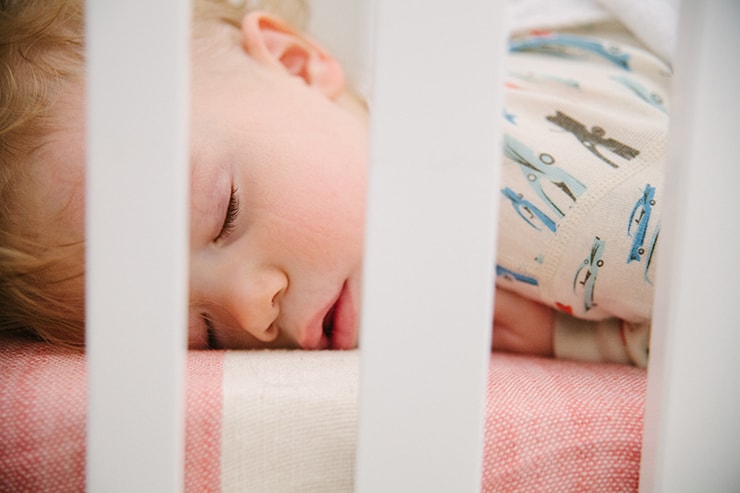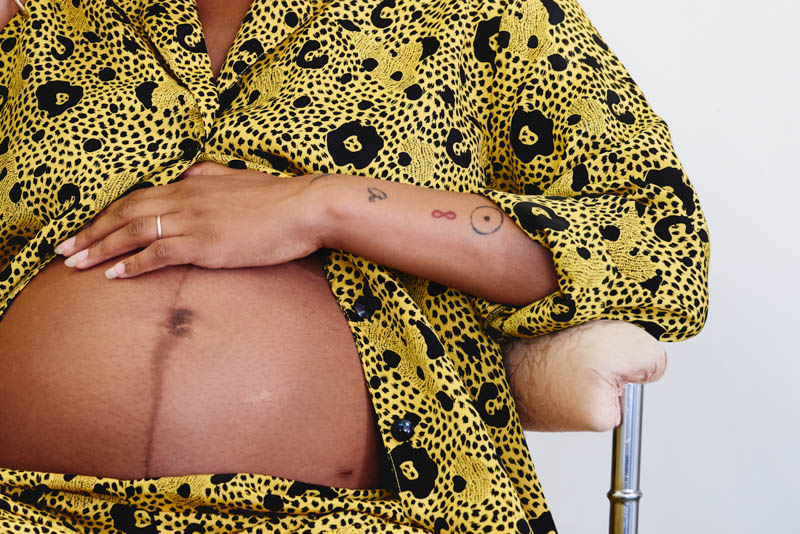
Sleep Training 101: Newborn To 12 Months
Written by Katie Hintz-Zambrano
Photography by Photography by James Kicinski-McCoy
Oh, the plight of getting your kid to sleep through the night. For some of us, it’s a breeze (seriously, congratulations!), and for the rest of us, it’s an on-and-off battle fraught with a barrage of emotions. From breaking bedwetting habits to the teeth-grinding agony of letting your child cry it out, we’ve tapped renowned sleep consultant Angelique Millette to guide us through it all, step by step, starting with months 0-12. (Don’t worry, help for moms of toddlers and older kids is on the way!) Here, we’ve boiled down her best advice. You’re welcome.
1. First things first, know what “sleeping through the night” actually means. In scientific terms, it’s defined as sleeping 5-8 hours straight by 6 months old. Not 12 hours straight, as some books might lead you to believe. Babies typically don’t drop a night feed until between 5 to 12 months of age, so they will be waking up.
2. Curb your expectations based on any issues you or your child might have. For example, if your child has acid reflux or colic (two major reasons for sleep disruption), or if there were complications with the birth, you might not have a “good sleeper” right off the bat.
3. Hold tight, though. Around 4-6 months, those aforementioned issues typically clear up and if they don’t, you can still introduce a sleep training or “learning” method. At this time babies start to organize their circadian rhythms (you’ll notice them staying up longer during the day, wanting to go to bed around 5-8 p.m., and sleeping a longer stretch from the time they go down to their first feed). Around 3-5 months, you should also be on the lookout for the five signs of self-soothing: sucking on hands and fingers, bringing hands to midline, burrowing into a parent’s armpit to turn off stimulation, developing a whiney, self-soothing cry, and rolling on his side or tummy. Once these milestones are met, “sleep training” becomes an option.
4. After your child is at least 6 to 12 weeks old, you should start to develop a quality bedtime routine, which means spending lots of time with your little one before the lights go out, starting an hour before you’re going to put him down. The quality of this time together helps your child separate from you and settle soundly. Millette explains that sleep has a lot to do with the baby’s relationship to his or her parents. Holding and snuggling you child, talking, reading books, and singing lullabies together will fill them up with lots of reassurance before you separate and say night-night. Also, keeping the wake time in the morning within a consistent 30-minute window will help tots fall asleep at bedtime.
5. Watch your child’s sleep habits. Is she waking up every 30-60 minutes after you’ve put her down and needs help getting back to sleep? Is she waking up every 2 hours (after each of her sleep cycles has ended)? Is she hungry? When you initially comfort your baby, try patting and shushing instead of picking her up or putting her on the boob or bottle right away. Give her a chance to possibly self-soothe back to sleep. For some babies, this might mean waiting it out a few minutes before going in to comfort them.
6. Around 4-6 months (and later for some babies), “sleep training ” ( or “sleep learning”) your child, in order to help them start to put themselves to sleep—and back to sleep—without your help, is an option. Of course, “crying it out” is not the only method. There’s Millette’s no-low cry method called The Rinse & Repeat™, which involves picking up, rocking, and consoling your baby when he wakes up and cries out, then putting him back down drowsy (but not asleep) and patting/shhhing to settle to sleep. If he wakes up again (which he probably will), you repeat the method. Eventually, after two weeks to 1-2 months, your baby should start to accept the idea of falling asleep outside of your arms and should be able to put himself to sleep. More traditional sleep training looks like the Interval Method, which involves putting your child to bed drowsy and coming in at set intervals (letting him cry it out for 5, 10, 15 minutes, etc.) and staying in the room for one minute, patting your child on the back, but not picking him up. Although the Interval method involves a lot of cringe-worthy crying, if it’s timed right, Millette says parents have a 95% success rate after 3-7 days. If your child is not crying less in 3-5 days, stop the training and try again in a few weeks or a month when they are ready.
7. Sleep regression happens, and you should expect it. Formerly awesome sleepers might start waking up several times a night around travel, illness, or big milestones, like when she learns to crawl, pull herself up, walk, talk, and when she’s cutting molars. Once you feel your baby has gotten past these changes, start your sleep training over again. Note that sleep regression at approximately 4 months (or 14-18 weeks) happens when the infant transitions from newborn sleep to baby sleep. They are also learning a load of new skills and might start to develop a sleep association that requires a parent to get back to sleep. This marks the beginning of an opportunity to sleep train. Around 12 months (walking, cutting molars), and 18-22 months (language acquisition), there are also big developmental milestones that cause children to sleep worse, and sometimes become more clingy.
8. Use your box of (safe) bedtime tools. Using a swaddle on an infant can be a lifesaver in the early months. Just make sure you don’t use it for too long. Once your baby is rolling, it’s no longer safe to wrap him up in a swaddle. Try transitioning the child into a sleep sack, which gives him a similarly warm and contained feeling, but also allows him to use his hands. Sleep sacks (especially somewhat tighter fitting ones) prevent older babies from crawling out of their cribs and can delay the transition to a toddler bed, too. If you’re introducing a lovey to your child, make sure it is small and breathable, since they will put it over their faces. Millette suggests using a small, breathable baby washcloth. Other useful sleep tools include white noise machines, black-out curtains, and pacifiers (as long as parents don’t have to replace them during the night, and if they are weaned before 9 months, which is when the idea of object permanence comes into play).
9. A note on belly sleepers. With SIDS paranoia running rampant, it’s not abnormal to get freaked out when your 4-month-old child starts flipping over and sleeping face-down in her crib. But as long as she’s not swaddled and the bed is set up safely (nothing in it, save for your baby in a sleep sack, tight crib sheet, and a very small lovey), Millette advises not flipping the baby back onto her back. The tot will eventually move her head and start moving all around the crib, all night long.
10. And what about naps? There is no research that shows that 100% of naps have to happen in the crib or co-sleeper. In fact, babies consolidate daytime sleep in the first 4-9 months and go from 3-4 naps per day at 4 months to 2 naps per day by 8-9 months. So, try for 1-2 long (45-120 minute) naps in the crib, co-sleeper, or bassinet, but also try and get out for a walking or flexible nap every day. Millette aims for 70% of naps on a flat surface and without movement. You can use any number of methods to help teach your baby to learn to put himself to sleep and learn to sleep past the dreaded 30-minute pop-up. Millette likes to use her aforementioned The Rinse & Repeat™ method and her nap-training method. Be prepared to hear more crying if using the nap-training method and try not to night-sleep train and nap-sleep train at the same time, otherwise your baby spends a lot of time crying and not getting any restorative sleep. Also, try using The Rinse & Repeat™ or nap training earlier in the day when babies are better at learning something new.
Share this story



